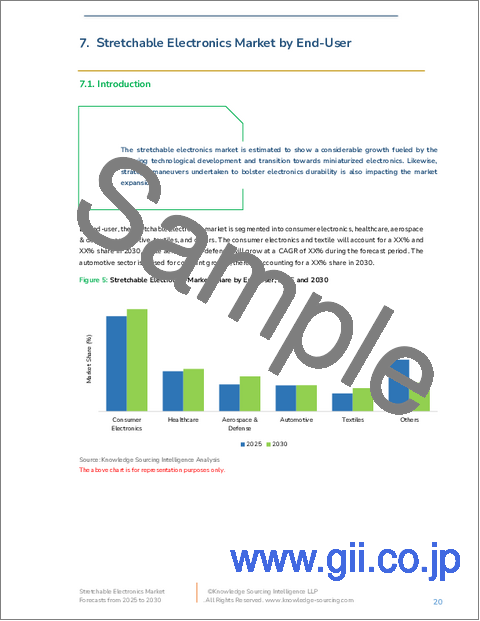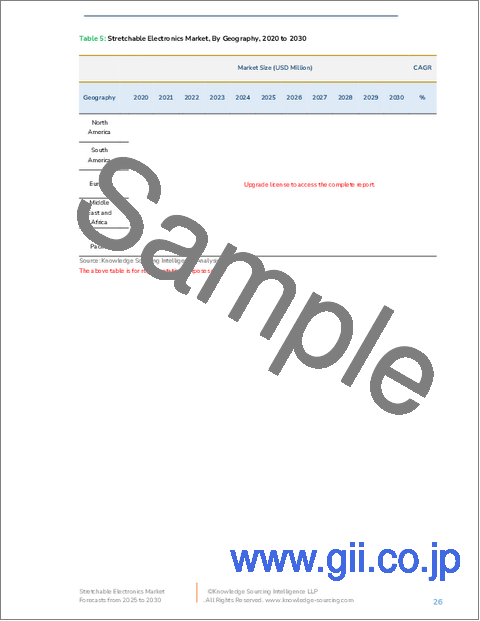|
|
市場調査レポート
商品コード
1775485
ストレッチャブル・エレクトロニクスの世界市場:予測(2025年~2030年)Stretchable Electronics Market - Forecasts from 2025 to 2030 |
||||||
カスタマイズ可能
|
|||||||
| ストレッチャブル・エレクトロニクスの世界市場:予測(2025年~2030年) |
|
出版日: 2025年06月30日
発行: Knowledge Sourcing Intelligence
ページ情報: 英文 165 Pages
納期: 即日から翌営業日
|
全表示
- 概要
- 目次
世界のストレッチャブル・エレクトロニクスの市場規模は、CAGR27.91%で、2025年の6億4,710万米ドルから2030年には22億1,569万3,000米ドルに成長すると予測されています。
幅広い産業への応用
ストレッチャブル・エレクトロニクスは、その柔軟性、軽量性、高性能により、自動車、ヘルスケア、家電製品をはじめとするさまざまな分野に不可欠です。2024年、自動車業界では、電気自動車(EV)や自律走行技術の台頭により、スマートカーディスプレイやセンサーにおけるストレッチャブル・エレクトロニクスの需要が急増しました。ヘルスケアでは、リアルタイムの健康モニタリングのための伸縮可能なウェアラブルセンサーが支持を集め、医療用パッチへの採用が20%増加しました。スマートウォッチや折りたたみ式デバイスを含む家電製品は、小型化されたストレッチャブルコンポーネントを活用して機能を強化し、市場の成長を後押ししています。
技術の進歩
材料と製造プロセスの革新が市場拡大を加速しています。2023年には、伸縮性ポリマーと導電性インクの進歩により、低コストで高性能なデバイスの開発が可能になりました。これらの技術は、ストレッチャブル・エレクトロニクスの迅速なプロトタイピングと生産をサポートし、メーカーの開発コストを最大15%削減します。ストレッチャブル回路とワイヤレス通信機能との統合により、IoT機器での利用が強化され、業界全体での採用がさらに促進されます。
政府の取り組み
政府の支援政策がエレクトロニクス部門を後押しし、ストレッチャブル・エレクトロニクスの需要を間接的に押し上げています。2024年、インドのProduction Linked Incentive(PLI)スキームは、26年度までにエレクトロニクス生産で3,000億米ドルを達成することを目標とし、フレキシブル技術やストレッチャブル技術のイノベーションを促進しました。EUのHorizon Europeプログラムなど、欧州における同様のイニシアティブは、先端エレクトロニクスの研究開発に12億米ドルを割り当て、自動車やヘルスケア用途のストレッチャブル・エレクトロニクスを支援しています。
市場の課題
高い開発コスト
導電性エラストマーのような特殊材料を含むストレッチャブル・エレクトロニクスの複雑な製造工程は、高コストをもたらします。2024年、伸縮可能センサーのプロトタイプ開発にかかる平均コストは10万米ドルであり、新興国市場の中小企業による採用は制限されています。
技術的複雑性
ストレッチャブル・エレクトロニクスを既存のシステムに統合するには、高度な工学的専門知識が必要です。2023年には、自動車用ディスプレイの硬質部品との互換性の問題がアジア太平洋での展開を遅らせ、一部の地域で市場成長が鈍化しました。
限られた拡張性
ストレッチャブル・エレクトロニクスの生産規模は、材料の制約と歩留まりの低さにより、依然として課題となっています。2024年には、希少導電材料のサプライチェーンの混乱により生産コストが10%上昇し、開発途上地域におけるスケーラビリティに影響を与えました。
市場セグメンテーション分析
コンポーネント別
伸縮可能な導電性インクを含む導電体が、フレキシブル回路やセンサーへの使用により、2024年の市場シェア40%で優位を占めました。電気活性ポリマーは、その柔軟性と生体適合性からウェアラブル機器や医療機器での需要が牽引し、最も急成長している分野です。
エンドユーザー別
自動車セグメントは、EVやスマートビークルにおけるフレキシブルディスプレイやセンサーの需要に牽引され、2024年には35%のシェアを占めてトップに立ちました。ヘルスケアは最も急成長しているセグメントであり、伸縮可能なセンサーによって患者の連続モニタリングが可能になります。ウェアラブルデバイスや折りたたみ式デバイスを含む家電製品も大きく貢献しています。
用途別
ウェアラブルセンサーなどのオンボディ・エレクトロニクスは、健康モニタリングやフィットネス・トラッキングに使用されるため、圧倒的なシェアを占めています。車載エレクトロニクスは、柔軟なインターフェースを必要とするコネクテッドカーや自律走行車の台頭に支えられて急成長しています。
地理的洞察
北米が大きなシェアを占め、2024年の市場収益の33%を占めました。CelLinkやFrore Systemsのような新興企業や、大手企業がバッテリー効率に注力していることが要因です。欧州がこれに続き、ドイツと英国が自動車とヘルスケア用途に投資しています。アジア太平洋は、インドのエレクトロニクス生産目標や中国のウェアラブル技術の進歩に後押しされ、CAGR19%と予測される急成長地域です。
競合情勢
デュポン、3M、パナソニック、イノラックス・コーポレーションなどの主要企業は、研究開発や戦略的提携を通じて技術革新を推進しています。2024年、デュポンは車載ディスプレイ用の新しい伸縮性導電インクを発表し、耐久性を向上させました。Innoluxは、大型フレキシブル車載ディスプレイの需要急増を予測し、車載用途の市場リーダーとして位置づけています。
本レポートの主な利点
- 洞察に富んだ分析:主要地域および新興地域を網羅し、顧客セグメント、政府政策および社会経済要因、消費者嗜好、業界、その他のサブセグメントに焦点を当てた詳細な市場考察を得ることができます。
- 競合情勢:世界の主要企業が採用している戦略的動きを理解し、適切な戦略による市場浸透の可能性を理解することができます。
- 市場動向と促進要因:ダイナミックな要因と極めて重要な市場動向、そしてそれらが今後の市場展開をどのように形成していくかを探ります。
- 実行可能な提言:ダイナミックな環境の中で新たなビジネスストリームと収益を発掘するための戦略的意思決定に洞察を活用します。
- 幅広い利用者に対応:新興企業、研究機関、コンサルタント、中小企業、大企業にとって有益で費用対効果が高くなっています。
レポートの主な活用方法
業界・市場考察、事業機会評価、製品需要予測、市場参入戦略、地理的拡大、設備投資の決定、規制の枠組みと影響、新製品開発、競合の影響
調査範囲
- 2022年~2024年の実績データと2025年~2030年の予測データ
- 成長機会、課題、サプライチェーンの展望、規制枠組み、動向分析
- 競合のポジショニング、戦略、市場シェア分析
- セグメントと各国を含む地域の収益成長と予測分析
- 企業プロファイル(主に戦略、製品、財務情報、主要な発展など)
目次
第1章 エグゼクティブサマリー
第2章 市場スナップショット
- 市場概要
- 市場の定義
- 調査範囲
- 市場セグメンテーション
第3章 ビジネス情勢
- 市場促進要因
- 市場抑制要因
- 市場機会
- ポーターのファイブフォース分析
- 業界バリューチェーン分析
- ポリシーと規制
- 戦略的提言
第4章 技術展望
第5章 ストレッチャブル・エレクトロニクス市場:コンポーネント別
- イントロダクション
- 回路
- 電池
- 電気活性ポリマー
- その他
第6章 ストレッチャブル・エレクトロニクス市場:基質別
- イントロダクション
- 熱可塑性ポリウレタン
- シリコン
- その他
第7章 ストレッチャブル・エレクトロニクス市場:エンドユーザー別
- イントロダクション
- 家電
- ヘルスケア
- 航空宇宙および防衛
- 自動車
- 繊維
- その他
第8章 ストレッチャブル・エレクトロニクス市場:地域別
- イントロダクション
- 北米
- 米国
- カナダ
- メキシコ
- 南米
- ブラジル
- アルゼンチン
- その他
- 欧州
- ドイツ
- フランス
- 英国
- スペイン
- その他
- 中東・アフリカ
- サウジアラビア
- アラブ首長国連邦
- その他
- アジア太平洋
- 中国
- インド
- 日本
- 韓国
- インドネシア
- その他
第9章 競合環境と分析
- 主要企業と戦略分析
- 市場シェア分析
- 合併・買収・協定・協業
- 競合ダッシュボード
第10章 企業プロファイル
- ABB Ltd.
- DuPont
- Forciot
- Enfucell Flexible Electronics Co. Ltd.
- Samsung Electronics
- LG Electronics
- Panasonic Corporation
- Yamaha Corporation
第11章 付録
- 通貨
- 前提条件
- 基準年と予測年のタイムライン
- 利害関係者にとっての主なメリット
- 調査手法
- 略語
The stretchable electronics market is expected to grow from USD 647.100 million in 2025 to USD 2,215.693 million in 2030, at a CAGR of 27.91%.
Wide Application Across Industries
Stretchable electronics are integral to multiple sectors, particularly automotive, healthcare, and consumer electronics, due to their flexibility, lightweight nature, and high performance. In 2024, the automotive industry saw a surge in demand for stretchable electronics in smart car displays and sensors, driven by the rise of electric vehicles (EVs) and autonomous driving technologies. In healthcare, stretchable wearable sensors for real-time health monitoring gained traction, with a 20% increase in adoption for medical patches. Consumer electronics, including smartwatches and foldable devices, leverage miniaturized stretchable components for enhanced functionality, fueling market growth.
Technological Advancements
Innovations in materials and manufacturing processes are accelerating market expansion. In 2023, advancements in stretchable polymers and conductive inks enabled the development of low-cost, high-performance devices. These technologies support rapid prototyping and production of stretchable electronics, reducing development costs by up to 15% for manufacturers. The integration of stretchable circuits with wireless communication capabilities enhances their use in IoT devices, further driving adoption across industries.
Government Initiatives
Supportive government policies are boosting the electronics sector, indirectly driving demand for stretchable electronics. In 2024, India's Production Linked Incentive (PLI) scheme aimed to achieve USD 300 billion in electronics production by FY26, fostering innovation in flexible and stretchable technologies. Similar initiatives in Europe, such as the EU's Horizon Europe program, allocated USD 1.2 billion for advanced electronics R&D, supporting stretchable electronics for automotive and healthcare applications.
Market Challenges
High Development Costs
The complex manufacturing processes for stretchable electronics, including specialized materials like conductive elastomers, result in high costs. In 2024, the average cost of developing a stretchable sensor prototype was USD 100,000, limiting adoption by smaller firms in emerging markets.
Technical Complexity
Integrating stretchable electronics with existing systems requires advanced engineering expertise. In 2023, compatibility issues with rigid components in automotive displays delayed deployments in Asia-Pacific, slowing market growth in some regions.
Limited Scalability
Scaling production of stretchable electronics remains challenging due to material constraints and low yield rates. In 2024, supply chain disruptions for rare conductive materials increased production costs by 10%, impacting scalability in developing regions.
Market Segmentation Analysis
By Component
Conductors, including stretchable conductive inks, dominated with a 40% market share in 2024, due to their use in flexible circuits and sensors. Electroactive polymers are the fastest-growing segment, driven by demand in wearable and medical devices for their flexibility and biocompatibility.
By End-User
The automotive segment leads, holding a 35% share in 2024, driven by demand for flexible displays and sensors in EVs and smart vehicles. Healthcare is the fastest-growing segment, with stretchable sensors enabling continuous patient monitoring. Consumer electronics, including wearables and foldable devices, also contribute significantly.
By Application
On-body electronics, such as wearable sensors, dominate due to their use in health monitoring and fitness tracking. In-vehicle electronics are growing rapidly, supported by the rise of connected and autonomous vehicles requiring flexible interfaces.
Geographical Insights
North America holds a significant share, contributing 33% of market revenue in 2024, driven by startups like CelLink and Frore Systems and major players' focus on battery efficiency. Europe follows, with Germany and the UK investing in automotive and healthcare applications. Asia-Pacific is the fastest-growing region, with a projected CAGR of 19%, fueled by India's electronics production goals and China's advancements in wearable technology.
Competitive Landscape
Key players, including DuPont, 3M, Panasonic, and Innolux Corporation, drive innovation through R&D and strategic collaborations. In 2024, DuPont introduced a new stretchable conductive ink for automotive displays, enhancing durability. Innolux forecasted a surge in demand for large-scale flexible car displays, positioning it as a market leader in automotive applications.
Key Benefits of this Report:
- Insightful Analysis: Gain detailed market insights covering major as well as emerging geographical regions, focusing on customer segments, government policies and socio-economic factors, consumer preferences, industry verticals, and other sub-segments.
- Competitive Landscape: Understand the strategic maneuvers employed by key players globally to understand possible market penetration with the correct strategy.
- Market Drivers & Future Trends: Explore the dynamic factors and pivotal market trends and how they will shape future market developments.
- Actionable Recommendations: Utilize the insights to exercise strategic decisions to uncover new business streams and revenues in a dynamic environment.
- Caters to a Wide Audience: Beneficial and cost-effective for startups, research institutions, consultants, SMEs, and large enterprises.
What do businesses use our reports for?
Industry and Market Insights, Opportunity Assessment, Product Demand Forecasting, Market Entry Strategy, Geographical Expansion, Capital Investment Decisions, Regulatory Framework & Implications, New Product Development, Competitive Intelligence
Report Coverage:
- Historical data from 2022 to 2024 & forecast data from 2025 to 2030
- Growth Opportunities, Challenges, Supply Chain Outlook, Regulatory Framework, and Trend Analysis
- Competitive Positioning, Strategies, and Market Share Analysis
- Revenue Growth and Forecast Assessment of segments and regions including countries
- Company Profiling (Strategies, Products, Financial Information, and Key Developments among others.
Stretchable Electronics Market Segmentation
By Component
- Circuit
- Batteries
- Electroactive Polymers
- Others
By Substrate
- Thermoplastic Polyurethane
- Silicones
- Others
By End-User
- Consumer Electronics
- Healthcare
- Aerospace & Defense
- Automotive
- Textiles
- Others
By Geography
- North America
- United States
- Canada
- Mexico
- South America
- Brazil
- Argentina
- Others
- Europe
- Germany
- UK
- France
- Spain
- Italy
- Others
- Middle East and Africa
- Saudi Arabia
- Israel
- Others
- Asia Pacific
- China
- Japan
- India
- Indonesia
- South Korea
- Taiwan
- Others
TABLE OF CONTENTS
1. EXECUTIVE SUMMARY
2. MARKET SNAPSHOT
- 2.1. Market Overview
- 2.2. Market Definition
- 2.3. Scope of the Study
- 2.4. Market Segmentation
3. BUSINESS LANDSCAPE
- 3.1. Market Drivers
- 3.2. Market Restraints
- 3.3. Market Opportunities
- 3.4. Porter's Five Forces Analysis
- 3.5. Industry Value Chain Analysis
- 3.6. Policies and Regulations
- 3.7. Strategic Recommendations
4. TECHNOLOGICAL OUTLOOK
5. STRETCHABLE ELECTRONICS MARKET BY COMPONENTS
- 5.1. Introduction
- 5.2. Circuits
- 5.3. Batteries
- 5.4. Electroactive Polymers
- 5.5. Others
6. STRETCHABLE ELECTRONICS MARKET BY SUBSTRATE
- 6.1. Introduction
- 6.2. Thermoplastic Polyurethane
- 6.3. Silicones
- 6.4. Others
7. STRETCHABLE ELECTRONICS MARKET BY END-USER
- 7.1. Introduction
- 7.2. Consumer Electronics
- 7.3. Healthcare
- 7.4. Aerospace & Defense
- 7.5. Automotive
- 7.6. Textiles
- 7.7. Others
8. STRETCHABLE ELECTRONICS MARKET BY GEOGRAPHY
- 8.1. Introduction
- 8.2. North America
- 8.2.1. USA
- 8.2.2. Canada
- 8.2.3. Mexico
- 8.3. South America
- 8.3.1. Brazil
- 8.3.2. Argentina
- 8.3.3. Others
- 8.4. Europe
- 8.4.1. Germany
- 8.4.2. France
- 8.4.3. United Kingdom
- 8.4.4. Spain
- 8.4.5. Others
- 8.5. Middle East and Africa
- 8.5.1. Saudi Arabia
- 8.5.2. UAE
- 8.5.3. Others
- 8.6. Asia Pacific
- 8.6.1. China
- 8.6.2. India
- 8.6.3. Japan
- 8.6.4. South Korea
- 8.6.5. Indonesia
- 8.6.6. Others
9. COMPETITIVE ENVIRONMENT AND ANALYSIS
- 9.1. Major Players and Strategy Analysis
- 9.2. Market Share Analysis
- 9.3. Mergers, Acquisitions, Agreements, and Collaborations
- 9.4. Competitive Dashboard
10. COMPANY PROFILES
- 10.1. ABB Ltd.
- 10.2. DuPont
- 10.3. Forciot
- 10.4. Enfucell Flexible Electronics Co. Ltd.
- 10.5. Samsung Electronics
- 10.6. LG Electronics
- 10.7. Panasonic Corporation
- 10.8. Yamaha Corporation
11. APPENDIX
- 11.1. Currency
- 11.2. Assumptions
- 11.3. Base and Forecast Years Timeline
- 11.4. Key benefits for the stakeholders
- 11.5. Research Methodology
- 11.6. Abbreviations






